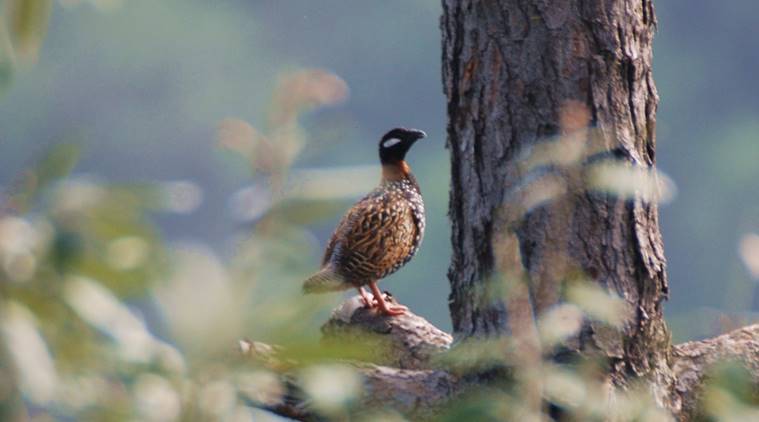 We don’t call them game birds for nothing. (Source: Express Photo by Ranjit Lal)
We don’t call them game birds for nothing. (Source: Express Photo by Ranjit Lal)
It’s happened so many times that you might think you would be wiser now — but you never are — and are inevitably caught by surprise every time. Wandering about in scrubby thorny jungles, fields, or, as several times in my case, on the Delhi Ridge, with your head in the air, imbibing nature, even actively birding, you might in a sudden panicky moment think you have stepped on a landmine. From underfoot comes an explosive “BOUFF!” followed by a “BHHHRRRR!” and something rufous brown blasts off, careening in a snaking blur. If ever there was a harmless landmine or mortar, this is it. Except for a racing heart and the feeling that you’ve been tricked yet again you are fine. The grey francolin has scored again!
Of course, you would have given it an equally big fright, if that’s any consolation for your shredded dignity. Normally, francolins — or partridges, as they were better known — prefer scuttling off on foot, jinking, swerving and ducking from one bush to the other as if under fire (they often are) as they try and get away from you. Flight is the last resort. Since their anaerobic white flight muscles rapidly burn glycogen — a stored form of glucose from carbohydrates — they cannot sustain flight beyond 50-100 metres. They, however, are smart. On landing, say, near a bush, they will continue to run so that when you reach the spot you think they are lying doggo but they would be long gone. There is good reason why they avoid you like the plague: they seem to know how good they taste. We don’t call them game birds for nothing.
Making an acquaintance of the grey francolins, the commonest of the tribe found across India, except the Northeast, is pretty easy. Don’t try spotting them, keep an ear out instead. They are to be heard in the mornings and evenings, in scrubby, lightly forested country fields and the village outskirts. A covey saunters around in Delhi’s Nicholson Cemetery, next door to my bedroom, waking me up every so often with their shrill pateela! pateela! pateela! calls. These rings can’t be put on snooze. First, the cock boots up with a clucking call, which rises to a penetrating kateetar-kateetar-kateetar! The lady, then, contributes a more subdued tee-tee-tee or kila-kila-kila and the pateela call is the combined duet of a mated pair.
The hungry and the brave will step out for tidbits at the feeders. Years ago at Sariska national park, I was delighted when a pair sauntered out of cover and came right up to us: jaunty, upright-looking, stub-tailed birds, about half the size of a hen, with an intricate basket-weave-patterned plumage in rufous, caramel and black. There’s a rufous throat patch encircled in black; the males have spurs on their legs.
When men are not hunting these partridges for dinner, they make them fight. Cheap thrills. The fighters, reared and trained since birth, are twice the weight of the wild ones. Easily tamed and following their owners around, these loyalists might give pet dogs a stiff competition.
In the wild, they have an eclectic diet — cereal seeds, berries, grass shoots and crops — even human excreta. Did that kill your appetite? They scratch around in small family parties of four to eight birds and there’s always something cheerful about a group making its jaunty way by the side of a field. They breed mainly in summer, laying around four to eight eggs in a pit, hidden under a tussock or clod, lined with grass.
From the foothills of the Himalayas up to the mountains, the stunning black francolin paces out his territory — this guy is a head-turner. He’s velvety black, scalloped in white and gold, with a copper-chestnut collar and milky white strokes on cheeks. Here, too, you are more likely to hear him before seeing him. Seemingly standing on tiptoe at a prominent post, he calls in a distinctly cheerful, high-pitched chk-chk-cheek-cheek-keryakek, delightfully decoded as lehsan-pyaaz-adrak. He likes wandering about with his partner, and, perhaps, a handful of family members, along the edges of fields and roosts in thick cover of tall grass clumps, sugarcane being one favourite. He may be found in the hills up till an altitude of 2,500 m. His wife is a paler version of him — no white on her cheeks or chestnut collar, only a faded chestnut patch on her nape.
It amazes me how difficult it is to winkle out partridges from their scrubby, biscuit-coloured environment even as they call ringingly from close quarters. Until, of course, you hear the explosion, and you know you have nearly stepped on one yet again.